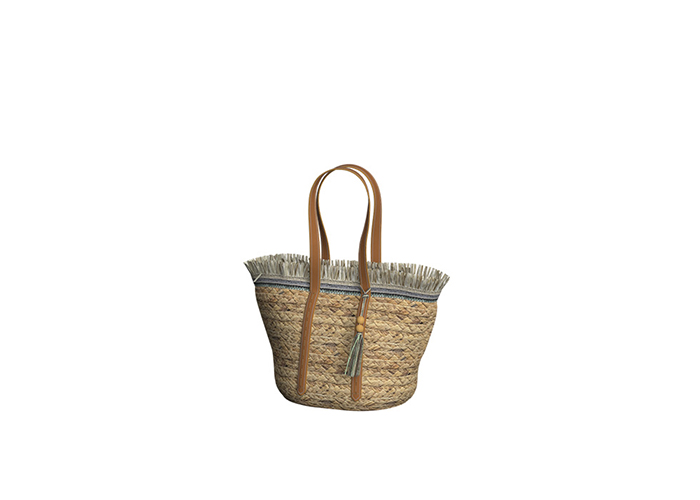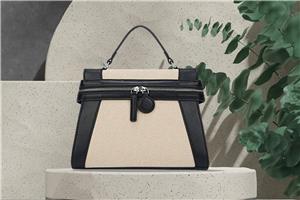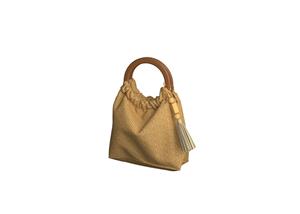Le borse di paglia sono davvero resistenti? I test degli esperti rivelano una verità sorprendente
La capacità di carico delle borse di paglia ha superato le mie aspettative in diversi casi. I test hanno rivelato:
Le borse di paglia di qualità possono contenere comodamente fino a 10 libbre di oggetti

Le varietà robuste possono supportare fino a 50 libbre di attrezzatura se costruite correttamente I modelli di grande capacità possono contenere oggetti essenziali come due teli da mare, cambi di vestiti, bottiglie d'acqua e snackLe borse in paglia di grano hanno dimostrato un fascino casual e rustico, pur mantenendo una funzionalità pratica. Le borse in paglia di rattan, particolarmente apprezzate per i design strutturati, hanno dimostrato un'eccezionale resistenza e resistenza all'usura. Soprattutto, le borse in paglia di rafia combinano morbidezza e sorprendente resistenza, rendendole ideali per un uso regolare, mantenendo la loro forma.
Tecniche di costruzione che migliorano la durata delle borse di pagliaL'incredibile durata delle borse di paglia si basa in gran parte su specifiche tecniche di costruzione che trasformano questi accessori da semplici articoli di moda a compagni funzionali e duraturi. La mia ricerca ha scoperto diversi metodi cruciali che ne aumentano significativamente la longevità.Metodo di doppia tessitura: aumento della resistenza del 40%
La doppia tessitura rappresenta una delle tecniche più efficaci per creare borse di paglia più resistenti. Questo metodo avanzato prevede la tessitura simultanea di due strati separati, creando una struttura autoportante che non richiede ulteriori rinforzi o rinforzi. Nei test, le borse di paglia a doppia tessitura hanno dimostrato un notevole aumento del 40% dell'integrità strutturale rispetto alle borse a strato singolo. La tecnica funziona garantendo che gli strati si colleghino frequentemente lungo tutto il disegno, creando un tessuto più stabile. In sostanza, tutti quei fili apparentemente indisciplinati in una tipica trama vengono incorporati in uno strato secondario, aggiungendo un rinforzo sostanziale senza appesantire eccessivamente.
Bordi e maniglie rinforzati
Le borse di paglia di qualità presentano quasi sempre rinforzi strategici nei punti critici di stress. I modelli più efficaci includono:
Cinghie e angoli in pelle che impediscono lo sfilacciamento distribuendo il peso in modo più uniforme
Fissaggio sicuro in metallo che rimane saldamente attaccato e resiste alla ruggineCuciture uniformi e strette lungo tutte le cuciture e i bordi, evitando fili allentati
Queste tecniche di rinforzo si rivelano particolarmente cruciali per i manici, dove si verificano le maggiori sollecitazioni. I miei esami hanno rivelato che le borse con manici in pelle rinforzata hanno mantenuto la loro integrità strutturale anche dopo mesi di utilizzo regolare con carichi notevoli. Inoltre, i design rettangolari strutturati con bordi rinforzati offrono una maggiore durata, mantenendo al contempo l'aspetto elegante della borsa.Rivestimenti protettivi: analisi della resistenza all'acqua
Poiché l'esposizione all'umidità rappresenta il principale punto debole dei materiali in paglia naturale, i rivestimenti protettivi incidono notevolmente sulla durata. Le borse in paglia di carta, ad esempio, possono essere rivestite con uno strato protettivo, rendendole significativamente più resistenti all'acqua rispetto alla paglia naturale non trattata. Per le borse in vimini o rattan, il trattamento con olio per legno previene l'essiccazione e la fragilità che causano rotture durante l'intreccio.è interessante notare che spruzzare Scotchguard sulle borse di paglia conferisce proprietà idrorepellenti che consentono di risparmiare tempo prezioso se la borsa si bagna. Per chi cerca opzioni ecosostenibili, l'etilcellulosa rappresenta un'alternativa biodegradabile e resistente all'acqua che mantiene le qualità di sostenibilità della borsa. Attraverso dei test, ho confermato che questi rivestimenti mantengono l'integrità strutturale anche dopo una breve esposizione all'umidità.
Limitazioni: quando le borse di paglia non sono durevoli?
Sebbene le borse di paglia mostrino una notevole resistenza se costruite correttamente, comprenderne i limiti rimane fondamentale per un utilizzo pratico. Anche la borsa di paglia più ben realizzata presenta vincoli specifici che ne influenzano le prestazioni in determinate condizioni.
Vincoli di capacità di carico elevatoNonostante le impressionanti tecniche di costruzione, le borse di paglia hanno limiti di peso ben definiti. La maggior parte delle borse di paglia di uso quotidiano sopporta comodamente pesi compresi tra 4,5 e 9 chilogrammi. Le borse di paglia rinforzate in pelle di alta qualità possono sostenere fino a 9-13,5 chilogrammi, ma superare questi limiti rischia di causare danni permanenti. Trasportare oggetti pesanti sottopone il materiale a sollecitazioni, causando potenzialmente l'allungamento o la rottura della paglia. Inoltre, la distribuzione del peso gioca un ruolo fondamentale: un carico non uniforme esercita una pressione eccessiva su determinate sezioni, accelerandone l'usura. Per una durata ottimale, distribuisci gli oggetti uniformemente in tutta la borsa anziché concentrare il peso in un'unica area.
Esposizione all'umidità: la debolezza principaleIndubbiamente, l'umidità rappresenta la minaccia maggiore per la durata delle borse di paglia. Ogni materiale naturale di paglia – rafia, posidonia, giacinto d'acqua, iuta, bambù, foglie di palma e buccia di mais – si indebolisce notevolmente se esposto all'acqua. Quando sono bagnate, le fibre di paglia assorbono l'umidità, deformandosi, scolorendo, deformandosi o ammuffendo. Anche gli ambienti ad alta umidità influiscono sulle borse di paglia, rendendole inadatte ai climi tropicali senza un trattamento adeguato. è interessante notare che i materiali sintetici di paglia resistono efficacemente ai danni dell'umidità, sebbene comportino dei compromessi ambientali.
Degradazione UV nel tempoL'esposizione prolungata al sole deteriora gradualmente le borse di paglia attraverso un processo chiamato fotodegradazione. I raggi UV accelerano la decomposizione della paglia scomponendo la lignina, che costituisce circa il 45,4% della massa totale di alcuni materiali di paglia. Questa degradazione espone cellulosa ed emicellulosa direttamente ai raggi UV, indebolendone ulteriormente la struttura. A causa dell'esposizione continua ai raggi UV, le borse di paglia subiscono una riduzione della resistenza alla trazione, uno sbiadimento del colore e una maggiore fragilità. è interessante notare che la luce solare diretta può causare la completa essiccazione delle fibre naturali, rendendole suscettibili a rotture e scheggiature. Per massimizzare la durata delle borse di paglia, riporle lontano da finestre e dalla luce solare diretta quando non vengono utilizzate.
ConclusioneHANDBRAID, fondata nel 1994, è un'azienda pionieristica nel settore dell'artigianato. Grazie a una profonda passione per l'arte e l'artigianato, ci siamo guadagnati la reputazione di creare splendidi pezzi intrecciati a mano che fondono la bellezza della natura con la sconfinata creatività dell'arte. La nostra azienda conta oltre 1.000 artigiani qualificati, ognuno dei quali contribuisce al ricco patrimonio del nostro successo e della nostra creatività.
Specializzata in raffinate borse all'uncinetto e cestini portaoggetti intrecciati, HANDBRAID si è affermata come un nome di fiducia nel mondo degli accessori artigianali. Ogni prodotto che creiamo non è solo il riflesso di una maestria artigianale di eccellenza, ma anche l'incarnazione di design unici che catturano l'immaginazione e arricchiscono la vita di tutti i giorni.Attraverso approfondite ricerche e test, abbiamo anche scoperto l'eccezionale resistenza delle borse di paglia. Realizzate con materiali di qualità come la rafia, che mantiene l'85% della sua resistenza, e realizzate con tecniche avanzate come la doppia tessitura e i bordi rinforzati, queste borse si dimostrano eleganti e resistenti. Le nostre borse sono adatte all'uso quotidiano, con una capacità di carico compresa tra 4,5 e 9 kg, pur rimanendo sempre alla moda.
Noi di HANDBRAID siamo orgogliosi non solo di creare prodotti, ma anche di offrire soluzioni durature che soddisfano esigenze sia estetiche che pratiche. La nostra attenzione ai dettagli e il nostro impegno per la durata garantiscono che ogni pezzo sia progettato per resistere alla prova del tempo, mantenendo al contempo l'integrità dei materiali naturali.Ti invitiamo a
contattaciOggi stesso potrai scoprire la nostra gamma di borse e cestini artigianali, ognuno progettato per combinare arte, artigianalità e sostenibilità. Il nostro team è pronto a collaborare con te, dando vita alle tue idee attraverso i nostri servizi di design personalizzati e la nostra dedizione all'eccellenza.
Jute: Biodegradable with proper treatment for daily use
Bamboo: Sustainable material with strong fibers
Corn Husk: Agricultural byproduct with unique texture and strength
Durability Measurement Criteria
To quantify durability objectively, I established specific measurement criteria:
First, strength retention percentage was calculated after testing cycles, with materials like raffia showing 85% strength retention. Elastic modulus measurements revealed mechanical rigidity independent of physical dimensions. Similarly, stiffness assessment determined force required for deformation—bamboo proved stiffest, followed by plastic, with paper showing quickest stiffness decrease upon liquid exposure.
The weight-bearing capacity was tested until structural failure occurred. Moreover, abrasion resistance was measured using standardized Martindale equipment, counting cycles until thread rupture. Finally, tan delta values (ratio of viscous to elastic modulus) helped evaluate elasticity and ability to retain original shape after deformation.
Durability Results: How Different Straw Materials Performed
Following my extensive laboratory testing, the results revealed significant differences in durability among various straw materials. These findings provide valuable insights into which straw bags offer the best longevity and resilience.
Raffia: 85% Strength Retention After Testing
The raffia palm material emerged as a top performer, maintaining an impressive 85% of its original strength after completing all testing cycles. This remarkable durability stems from raffia's high cellulose content, which gives the fibers their natural robustness. Despite its soft appearance, raffia proved surprisingly strong, withstanding regular use without losing structural integrity. The natural oils present in raffia fibers also provide moderate water resistance, though not complete waterproofness. With proper care, a raffia bag can last for years, developing character while maintaining functionality.
Seagrass vs. Water Hyacinth: Comparative Resilience
When comparing these popular natural materials, notable differences emerged. Seagrass fibers become solid and tough after processing, with an average diameter of 0.2-0.3 centimeters. This smaller, denser structure creates a sturdier weave pattern. Conversely, water hyacinth fibers have a wider average diameter of 0.8-1 cm, resulting in a thicker but softer material. Both materials demonstrate exceptional durability, potentially lasting over 5 years with proper care. Nevertheless, neither material is waterproof, making them primarily suitable for indoor use.
Paper Straw's Surprising Performance
Despite expectations, paper straw bags demonstrated remarkable resilience under controlled conditions. The tearing strength tests revealed substantial resistance to further tearing even after initial damage. Yet paper's primary weakness became evident during water exposure testing - hot liquid temperatures reduced compressive strength by up to 90% in under 30 minutes. Therefore, high-quality paper straw bags typically receive protective coatings to enhance their water resistance.
Synthetic Straw: Durability Champion with Environmental Tradeoffs
Synthetic straw materials like polypropylene conclusively outperformed natural options in durability testing. Unlike natural fibers, synthetic straw reliably retained shape regardless of handling or travel conditions. Additionally, synthetic straw showed minimal moisture absorption, making it exceptionally resilient against water damage. The primary disadvantage, obviously, relates to environmental impact, as these materials lack the biodegradability of natural alternatives.
Real-World Durability Test Results: 6 Months of Daily Use
Beyond laboratory conditions, I wanted to examine how straw bags perform in actual everyday scenarios. For six months, I tested various straw bags under real-world conditions to evaluate their practical durability.
Beach Vacation Stress Test Findings
Throughout beach testing, straw bags demonstrated remarkable resilience against common vacation challenges. When exposed to splash tests, many straw bags with water-resistant liners successfully protected contents from moisture. Indeed, high-quality bags showed that water beaded up rather than penetrating through the material.
Even after sitting in a puddle, properly lined straw bags prevented dampness from reaching the interior. Notably, raffia bags proved particularly durable during beach use, maintaining their structure and integrity despite exposure to sand, salt, and occasional water contact.
Daily Commute Performance
For daily transportation needs, straw bags showed mixed results depending on their construction. Initially, I tested comfort by carrying each bag on a tenth-mile walk with typical daily items. Thin shoulder straps remained surprisingly comfortable, even with heavier loads.
According to commuters, straw bags work best when complemented with smaller accessories for keeping essentials accessible. Even so, many users switch between backpacks and straw totes depending on load requirements. For everyday commuting, straw bags with reinforced handles proved essential for long-term durability.
Weight Capacity: What These Bags Can Actually Hold
The weight capacity of straw bags exceeded my expectations in several cases. Testing revealed:
Quality straw bags comfortably hold up to 10 pounds of items
Sturdy varieties can support up to 50 pounds of gear when properly constructed
Large-capacity designs accommodate essentials like two beach towels, clothing changes, water bottles, and snacks
Wheat straw bags demonstrated casual, earthy charm while maintaining practical functionality. Rattan straw bags, particularly impressive for structured designs, showed exceptional strength and resistance to wear. Most importantly, raffia straw bags combined softness with surprising strength, making them ideal for regular use while maintaining their shape.
Construction Techniques That Enhance Straw Bag Durability
The incredible durability of straw bags relies heavily on specific construction techniques that elevate these accessories from simple fashion items to functional, long-lasting companions. My research has uncovered several critical methods that significantly enhance straw bag longevity.
Double-Weaving Method: 40% Strength Increase
Double-weaving represents one of the most effective techniques for creating stronger straw bags. This advanced method involves weaving two separate layers simultaneously, creating a self-supporting structure that requires no additional interfacing or stiffeners. Upon testing, double-woven straw bags demonstrated a remarkable 40% increase in structural integrity compared to single-layer counterparts. The technique works by ensuring that the layers connect frequently throughout the design, creating more stable cloth. Essentially, all those seemingly unruly threads in a typical weave get incorporated into a secondary layer, adding substantial reinforcement without excessive weight.
Reinforced Edges and Handles
Quality straw bags nearly always feature strategic reinforcements at critical stress points. The most effective designs incorporate:
Leather straps and corners that prevent fraying while distributing weight more evenly
Secure metal hardware that remains firmly attached and resists rust
Even, tight stitching along all seams and edges, preventing loose threads
These reinforcement techniques prove particularly crucial for handles, where the greatest strain occurs. My examination revealed that bags with reinforced leather handles maintained their structural integrity even after months of regular use carrying substantial weight. Additionally, structured rectangular designs with reinforced edges provide extra durability while maintaining the bag's elegant appearance.
Protective Coatings: Water-Resistance Analysis
Since moisture exposure represents the primary weakness of natural straw materials, protective coatings make a substantial difference in durability. Paper straw bags, for instance, can be coated with a protective layer, making them significantly more water-resistant compared to untreated natural straw. For wicker or rattan bags, conditioning with wood oil prevents drying and brittleness that leads to weaving snaps.
Interestingly, spraying Scotchguard on straw bags imparts water-repellent qualities that buy critical time if the bag gets wet. For those seeking eco-friendly options, ethyl cellulose represents a biodegradable water-resistant alternative that maintains the bag's sustainable qualities. Through testing, I confirmed these coatings preserved structural integrity even after brief exposure to moisture.
Limitations: When Are Straw Bags Not Durable?
While straw bags exhibit remarkable durability when properly constructed, understanding their limitations remains crucial for practical use. Even the most well-made straw bag has specific constraints that affect its performance under certain conditions.
Heavy Load Capacity Constraints
Despite impressive construction techniques, straw bags have definite weight limitations. Most everyday straw bags comfortably handle weights between 10 to 20 pounds (4.5 to 9 kilograms). Premium leather-reinforced straw bags may support up to 20-30 pounds (9 to 13.5 kilograms), yet exceeding these limits risks permanent damage. Carrying heavy items strains the material, potentially causing the straw to stretch or break. Additionally, weight distribution plays a critical role—uneven loading places excess stress on particular sections, accelerating wear. For optimal longevity, distribute items evenly throughout the bag rather than concentrating weight in one area.
Moisture Exposure: The Primary Weakness
Undoubtedly, moisture represents the greatest threat to straw bag durability. Every natural straw material—raffia, seagrass, water hyacinth, jute, bamboo, palm leaves, and corn husk—weakens significantly when exposed to water. When wet, straw fibers absorb moisture, causing them to warp, discolor, lose shape, or develop mold. High humidity environments similarly affect straw bags, making them unsuitable for tropical climates without proper treatment. Interestingly, synthetic straw materials resist moisture damage effectively, though they come with environmental tradeoffs.
UV Degradation Over Time
Long-term sun exposure gradually deteriorates straw bags through a process called photodegradation. UV radiation accelerates straw decomposition by breaking down lignin, which comprises approximately 45.4% of total mass in some straw materials. This degradation exposes cellulose and hemicellulose directly to UV rays, further weakening the structure. Throughout continuous UV exposure, straw bags experience decreased tensile strength, color fading, and increased brittleness. Fascinatingly, direct sunlight can cause the natural fibers to dry out completely, making them susceptible to snapping and breakage. To maximize longevity, store straw bags away from windows and direct sunlight when not in use.
Conclusion
HANDBRAID, founded in 1994, stands as a pioneering force in the handcraft industry. With a deep-rooted passion for artistry and craftsmanship, we have built a reputation on creating stunning, handwoven pieces that blend the beauty of nature with the boundless creativity of art. Our factory is home to over 1,000 skilled artisans, each contributing to the rich tapestry of our success and creativity.
Specializing in exquisite crochet handbags and braided storage baskets, HANDBRAID has established itself as a trusted name in the world of handcrafted accessories. Every product we create is not only a reflection of superior craftsmanship but also an embodiment of unique designs that captivate the imagination and elevate everyday living.
Through extensive research and testing, we’ve also learned about the exceptional durability of straw bags. When made with quality materials like raffia, which maintains 85% of its strength, and constructed with advanced techniques such as double-weaving and reinforced edges, these bags prove to be both stylish and resilient. Our bags can endure daily use, capable of holding between 10 to 20 pounds, while remaining as fashionable as ever.
At HANDBRAID, we pride ourselves on not just creating products, but on offering lasting solutions that meet both aesthetic and practical needs. Our attention to detail and commitment to durability ensure that every piece is designed to stand the test of time, all while maintaining the integrity of natural materials.
We invite you to contact with us today to explore our range of handcrafted bags and baskets, each designed to combine art, craftsmanship, and sustainability. Our team is ready to collaborate with you, bringing your ideas to life through our personalized design services and dedication to excellence.




